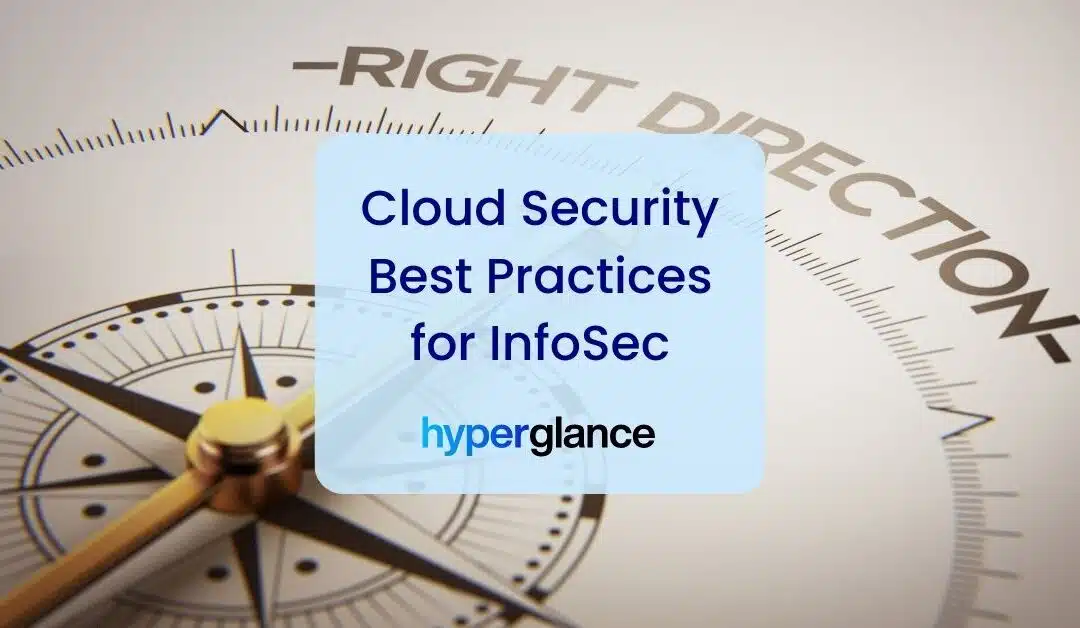Introduction
As more and more organizations shift their operations to the cloud, the importance of securing their data and applications in the cloud has become paramount. Cloud security presents a unique set of challenges - traditional security measures aren't always enough to protect against new threats and vulnerabilities that arise in the cloud environment.
In this cloud security guide, we will explore the key cloud security concepts, threats, and best practices that are essential for securing cloud-based infrastructure and applications. From understanding the shared responsibility model to implementing identity and access management, we'll cover a range of topics that are crucial for ensuring the security of cloud environments.
Whether you are an experienced security professional or just starting out in the field, this guide will provide you with the knowledge and skills necessary to effectively secure your organization's cloud-based assets.
What is InfoSec in Cloud Computing?
InfoSec in cloud computing refers to the set of practices, policies, and technologies used to secure the data, applications, and infrastructure hosted in a cloud environment.
With cloud computing, organizations can store and process their data and applications in remote servers managed by third-party service providers. While cloud computing offers numerous benefits, such as scalability, flexibility, and cost-efficiency, it also introduces new security risks and challenges that need to be addressed.
Cloud InfoSec involves implementing various security measures, such as access controls, encryption, intrusion detection and prevention, data backup and recovery, and vulnerability management, to protect against cyber threats and data breaches.
InfoSec professionals must have a clear understanding of the shared responsibility model, where the cloud service provider and the customer have different roles and responsibilities in securing the cloud environment.
Effective InfoSec in cloud computing is critical for maintaining the confidentiality, integrity, and availability of sensitive information and ensuring that the cloud environment is secure and compliant with industry regulations and standards.
Important InfoSec & Cloud Security Concepts
There are several key cloud security concepts that organizations need to be aware of. By implementing these concepts, organizations can minimize the risk of cyber threats, protect sensitive data, and ensure compliance with industry regulations.
Shared Responsibility Model
The cloud service provider and the customer have different roles and responsibilities in securing the cloud environment. The cloud service provider is responsible for securing the infrastructure, while the customer is responsible for securing the data and applications hosted in the cloud. This requires a clear understanding of the shared responsibility model to ensure that both parties are doing their part to secure the environment.
Identity and Access Management
Identity and access management (IAM) is essential for managing user access to cloud-based resources. It involves controlling who has access to what, and how that access is granted. IAM solutions typically include authentication, authorization, and accounting mechanisms.
Encryption
Encryption is a critical concept in cloud security. It involves the conversion of data into a code or cipher to protect it from unauthorized access. Encryption can be used to protect data in transit and at rest in the cloud.
Network Security
Network security is the process of protecting the cloud infrastructure and data from cyber threats. This includes implementing firewalls, intrusion detection and prevention systems, and other security measures to prevent unauthorized access and attacks.
Compliance
Compliance is essential for organizations that store or process sensitive data in the cloud. This includes adhering to industry regulations such as HIPAA or PCI-DSS, which require strict security controls and data protection measures.
Incident Response
Incident response is the process of detecting and responding to security incidents in the cloud environment. This involves identifying the source of the incident, containing the damage, and restoring the environment to its original state.
Why is Cloud Security Important?
Cloud security is a critical aspect of your overall cybersecurity strategy.
It impacts the protection of your organization's data, applications, and infrastructure in the cloud. It helps protect your organization's valuable assets, stay compliant, and build trust with your customers and stakeholders.
Ultimately, all of these lend themselves to good business:
Data Protection: Safeguarding sensitive data from unauthorized access, data breaches, and leakage is a top priority. Cloud security measures help ensure that your data remains secure, confidential, and available only to authorized users.
Compliance: Organizations must meet various regulatory requirements depending on their industry and location (e.g. HIPAA, PCI-DSS, NIST). Effective cloud security helps maintain compliance with these regulations, avoiding potential fines and damage to your organization's reputation.
Business Continuity: Cloud security is vital for ensuring the availability and resilience of your IT infrastructure, enabling you to minimize downtime and maintain business continuity in the face of cyber threats or disasters.
Customer Trust: By implementing robust cloud security measures, you demonstrate your commitment to protecting customer data and privacy, fostering trust and confidence in your organization.
Major Cloud Security Threats
1. Data Breaches
This is one of the most significant cloud security threats, where attackers can gain unauthorized access to sensitive data stored in the cloud. Breaches can occur due to weak passwords, misconfigured servers, or vulnerabilities in the cloud infrastructure.
2. Insufficient Identity & Access Management (IAM)
Cloud environments require effective identity and access management to ensure that only authorized users can access sensitive data and applications. Insufficient identity and access management can lead to unauthorized access, data leaks, and other security breaches.
3. Lack of Encryption
Encryption is critical for protecting data in transit and at rest in the cloud. A lack of encryption can leave data vulnerable to interception and theft.
4. Misconfiguration
Misconfigured cloud servers can create security vulnerabilities, such as leaving data publicly accessible or misconfigured firewalls, which can expose sensitive data to the internet.
5. DDoS Attacks
Distributed denial-of-service (DDoS) attacks can overload cloud servers, causing downtime and disrupting operations. These attacks can be difficult to detect and mitigate, especially for small organizations without sufficient resources.
6. Insider Threats
Insider threats can occur when employees or contractors with access to sensitive data and applications intentionally or unintentionally expose them to risk. This can include sharing login credentials, using personal devices, or intentionally leaking data.
Challenges of Managing Cloud Security for InfoSec
Shared Responsibility Model
Cloud service providers typically follow a shared responsibility model, where the CSP is responsible for securing the underlying infrastructure, while customers are responsible for securing their data and applications within the cloud. For InfoSec professionals, understanding and adhering to this model is crucial to ensure that security measures are in place at all levels.
Data Protection & Privacy
The cloud often involves storing and processing sensitive data across multiple geographic locations. Ensuring data privacy and meeting various regulatory requirements (such as GDPR, HIPAA, and CCPA) can be a complex undertaking for InfoSec teams, especially when dealing with cross-border data transfers and storage.
Access Control and Identity Management
As organizations expand their cloud footprint, managing access to resources and maintaining strict access controls becomes increasingly difficult. InfoSec professionals must implement robust identity and access management (IAM) strategies to prevent unauthorized access, minimize the risk of insider threats, and maintain a clear audit trail of user activity.
Visibility & Monitoring
Traditional network monitoring tools may not be suitable for cloud environments, making it challenging for InfoSec teams to maintain visibility across all resources and detect potential threats. Adopting cloud-native monitoring tools and solutions that provide comprehensive visibility is essential to stay ahead of emerging security risks.
Configuration Management
Misconfigurations are a leading cause of security breaches in cloud environments. InfoSec professionals must develop and enforce strong configuration management policies, automate compliance checks, and ensure that changes are promptly and securely applied to minimize risks associated with misconfigurations.
Vendor Management
With the growing reliance on third-party cloud services and applications, InfoSec teams must carefully evaluate and manage the security posture of their vendors. This includes conducting regular security assessments, monitoring vendor access, and implementing stringent security requirements in contracts and service-level agreements (SLAs).
How To Choose The Best Cloud Security Tool
Selecting the right cloud security tool is a critical step in ensuring the protection of your organization's data and applications.
With a myriad of options available, it can be overwhelming to decide which tools best align with your specific security needs.
In this section, we'll outline some essential factors to consider when choosing cloud security tools for your InfoSec strategy.
Compatibility with your cloud environment: Before selecting a security tool, ensure that it is compatible with your cloud service provider (CSP) and supports the specific services and platforms you are using. Look for tools that offer seamless integration with your existing cloud infrastructure and can be easily incorporated into your workflow.
Comprehensive visibility and monitoring: Effective cloud security requires comprehensive visibility across your entire cloud environment. Choose tools that provide real-time monitoring and alerting capabilities, enabling you to detect and respond to potential threats quickly. For bonus points, look for a solution that offers detailed insights into metadata and resource usage.
Scalability and flexibility: As your organization grows and your cloud environment evolves, your security tools should be able to scale accordingly. Opt for something that can adapt to changes in your infrastructure and support the addition of new services, regions, and accounts without compromising on security.
Automation and orchestration: Cloud security tools that support automation and orchestration can significantly reduce the time and effort required for managing security policies, detecting threats, and responding to incidents. Look for tools that offer features like automated policy enforcement, threat detection, and remediation, as well as the ability to integrate with other security solutions for a cohesive security strategy.
Compliance management: Lots of organizations are subject to various regulatory requirements, such as NIST, HIPAA, or PCI DSS. Choose security tools that can help you maintain compliance by providing built-in policy templates, automated compliance checks, and detailed reporting capabilities.
Ease of use and support: A user-friendly interface and reliable support is essential when selecting a tool. Look for solutions that offer an intuitive dashboard, comprehensive documentation, and responsive customer support to help you navigate the learning curve (and tackle any issues you encounter!).
Cost and return on investment (ROI): When evaluating security tools, consider the overall cost and potential ROI. This includes factors like licensing fees, implementation costs, and the resources required for management and maintenance. Select a tool that offers a reasonable balance between cost and the value they provide in terms of enhancing your cloud security posture. Bonus points if the tool has cost optimization built-in - you might even end up saving money!
Take these factors into account and we're sure you'll find a cost-effective and best-in-class cloud security solution, like Hyperglance, that will ensure you're in pole position for your InfoSec journey.
Choose a Powerful Cloud Security Platform
If you're looking for a cloud security tool that's got your back, Hyperglance is the perfect place to start.
Trusted by the likes of the US Air Force, NASA, HealthDirect, and Gigamon, Hyperglance gives you complete cloud management. From complete confidence in your security posture and cost management, to enlightening, real-time architecture diagrams.
Monitor your cloud security & compliance, manage costs & reduce your bill, explore interactive diagrams & inventory, and utilize powerful built-in automation. Save time & money and get complete peace of mind.
Schedule a no-obligation 30-minute demo to find out how Hyperglance can help transform your organization's cloud security.

About The Author: Stephen Lucas
As Hyperglance's Chief Product Officer, Stephen is responsible for the Hyperglance product roadmap. Stephen has over 20 years of experience in product management, project management, and cloud strategy across various industries.
